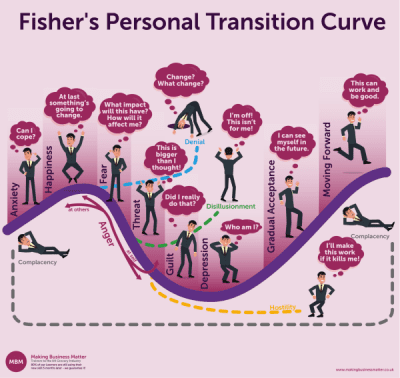Organisational Change is About the Here and Now
It’s a saying that has been used to death and beyond, ‘the only constant is change’. It’s so old that people cringe when the words are uttered. Another body shuddering saying that comes a close second is ‘the future is now’. In scientific terms this is nonsense and in actual terms, it’s nonsense too. I am guessing that the meaning behind the saying is that our awareness should be raised to consider the world around us.
Most of these were at some point spoken by self-confessed ‘experts’ and exploited by the many. Change is about the here and now. Dealing with it is challenging as it, within business terms, means an efficiency drive or implementation of improvement. Very often, this can mean a change in people and/or a redundancy situation. This reflection considers the impact on managers and people when organisational change occurs.
Stuck in the Middle
This reflection is not aimed at change leaders – those who create the change or identify the need for it. This is for managers who have the unenviable task of dealing with people it affects. You are possibly dealing with employees who will be leaving due to the organisational change. You could be managing new teams who emerge from it. Or, even creating something altogether new. The information you receive is critical for planning communications, setting the roadmap and thinking ahead about.
There is much writing about change leaders, change models and the ever-present acronym. However, there is little for the manager who is present and seemingly stuck in the middle.
The Challenge for the ‘Middle Manager’ When Facing Organisational Change
There is no doubt that when change or a change programme is planned, it affects our working and personal lives. As managers, we need to appreciate this from a business and economic point of view. The change could have been planned as a result of external forces, economic changes, better technology or a need to drive efficiency. Yet, how many managers really explain this, really get into the detail of the need for change itself?
Any business course will tell you that businesses are there to make a profit. Even when this is not a profit-making organisation, there is only ever a finite amount of money. Harsh? Absolutely. The facts are that this happens daily to small, medium and large organisations. Organisational change doesn’t always happen due to global economic downturns; rather it’s everyday developments that bring the need around.
The challenge for the middle manager is to communicate the change while ensuring productivity remains at a good level. It is also ensuring that they receive the right information from executives and deeply understand the change themselves. In previous iterations of management, I have been handed a script to communicate. I have also been provided a full briefing pack containing all the reasons for the change. Guess which worked the best? The point here is that peoples’ need for information is almost insatiable. Limiting this leads to people guessing, along with that comes a range of other human emotions that then require managing.

The Impact of Organisational Change
Managers who run or have been involved in change will say it is the most challenging time of their career. This is generally down to the fact that it drives emotion. Change can impact everyone – from receiving a small adaptation in process, a new role or even redundancy. I don’t believe that there is any worse feeling than knowing some people will have their jobs taken away from them.
Organisational change is different. It’s generally unseen and not the fault of the individual. However, the impact is about as bad as it gets in management terms. Managers are required to think deeply about the impact of change on others. What does it actually mean? What will the impact be? And what action do I need to take? The easy approach is to close your eyes and let it happen around you. But ask yourself, where is the dignity and respect for others in that?
Role Models
Change models are in plentiful supply. From Kurt Lewin’s Unfreeze-Change-Freeze model developed in the early 1900s to Richard Thaler’s ‘nudge theory’ from 2008. The issue is that all models, over time, become out of date and rightly challenged. Lewin’s model, for example, is criticised mainly for the ‘freeze’ element at the end.
Critics say that this is not flexible and change should be more fluid. Thaler’s ‘nudge theory’ is from the behavioural economic camp. The concept is good, but it does have a dark side. This being that we can affect behaviour for our own purposes. Thaler is famous for signing his books with a note saying ‘nudge for good’. A nod to the initial premise of the theory and that it should be utilised for its original meaning.
Organisational change models mostly have the employees at the core, let’s not be fooled though, change is coming. If the employees affected feel they own the change, this can make life much simpler. If they genuinely can affect it, then all the better. The hardest change is the one where redundancies are identified, and the business looks to streamline its operations or processes.
The Change Curve
Let’s not forget in the context of models the ‘change transition curve’. This is a tool that shows us the journey of people going through change. Generally starting with shock and denial (of the notice of change), working through to reality acceptance. You will find many variations of this, it is a useful model in an organisational change context… to a point!
Click on the image below to open a larger version:

A Divine Comedy?
It does remind me of Dante’s The Divine Comedy. An epic poem published in 1320, The Divine Comedy sees Dante’s journey to hell and back. Like contemporary thought leaders, Dante shaped many of the thoughts we have and believe today. My point is reflective, even Dante had a guide to walk him through his terrible and wonderful journey. In this respect, employees look to us as managers for guidance and information. If we continually ignore these requests, the onset of the change is much harder.
People rightly become emotive about change, many of the model’s state that engagement is the key. I believe this is absolutely right, it is, however, how we engage that is key. There will also be information that you can not provide. Sensitive information, personal details and so on. An informed manager should have integrity.

I have experienced many a manager who claims that they know more but can’t say as ‘them at the top told me not to’. This is a poor attempt at currying favour with the wider group. Don’t do it, people are not foolish. In fact, they probably appreciate you cannot mention certain elements. As Dante wrote: ‘You know all the ropes yet know not the first thing’.
Know the Roadmap
People I speak to often tell me that employees within a change programme have common issues. The first is that they never knew the change was coming. The second point is that they were never sure what was coming next.
While we use words like empathise, we can never really know what an individual goes through when they hear news of organisational change. Even small scale changes can cause upset for certain people. Having worked with several groups through a change management programme, it does matter about the detail but not immediately. Organisations like to issue a ‘pack’, this, in some instances illustrates the process and various other information. I am never convinced that all of this information goes in from the start. Once announced, employees generally need time to internalise, to ask those important questions, what if I am made redundant? What is the direct effect on me?
The very best managers ramp up the communication, allowing a truly open-door policy. This is an unusual time, productivity slows, smaller groups begin to form and of course, rumours begin. Yet, if the roadmap is explicit enough, it will provide all the information that is required.
When the consultations begin, when it ends, times and dates of communications. These are all key factors but absolutely useless if they only ever remain in a ‘pack’ of information. As people managers, our role is to bring that information alive, make is seen and make sense of it. In the early part of the organisational change, this may be a day by day process
Nearing the End
The best change process I experienced saw me being made redundant. Why was it effective? Every day there was the offer to question. It was understood that people took information and reflected over differing time periods. Time with the unions was never restricted and workshops were on offer to aid with CV’s and interview skills. We knew a large group were going to be affected, it was quickly identified who, and the support came in droves.

There was anger; I was 30 years old with a seven-month-old child. There was uncertainty and sadness. However, each of my concerns was met with a genuine offer of help and advice. I was left in no doubt that the change would happen. I had a very specific timescale to work to and get myself ‘mentally fit’ for the day. More than this, the manager listened and acted. He was genuine and authentic.
The Meaning of Authenticity
In previous reflections I mention authenticity. One specific trait which glares above others is having a realistic perception of reality. In his book Authentic: How to be yourself and why it matters, Stephen Joseph outlines 7 specific traits. The perception of reality is a key feature for managers within an organisational change process.
This is especially important when dealing with others. This is a serious situation, one which the manager can rarely change, but can define. What can you (the person affected by the change) and I (the manager) do right here right now? What can we positively affect that will enhance you now and for the future?
Helping people deal with the present and the future aids the understanding of the change. Moving people through the change by concentrating on the now and tomorrow is a powerful approach. However, let’s not get all misty-eyed in all this. An authentic manager also must deal with the people who refuse to move on from anger. It’s tough, it’s hard, then again no one said management was easy.
Final Thoughts
Managers who deal with change situations are required to communicate, show strong leadership and be authentic. Somewhere within that, there needs to be compassion and an appreciation that we are dealing with real people.
Real people deserve the opportunity to talk openly about the effects of change on them. Authentic management leaves people feeling as though they received the very best treatment. That might not be in the moment, but people consider and reflect further down the line. They will remember you, not a change or HR process. This is not about a legacy, just being human and providing a human approach.




